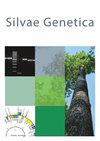Genetic tolerance to Ceratocystis wilt in melina (Gmelina arborea Roxb.)
IF 1
4区 农林科学
Q3 FORESTRY
引用次数: 1
Abstract
Abstract Gmelina arborea is the second most planted tree species in Costa Rica, and one of the most important in several Latin American countries. In recent years, a disease caused by Ceratocystis fimbriata, has spread throughout Latin America, leading to the complete root of the tree in a few months. This study was conducted to evaluate the incidence, severity and genetic tolerance control of the Ceratocystis wilt in G. arborea. Data is based on a 2.4-year-old clonal trial, with 34 elite genotypes, at Río Jiménez, Guácimo in the Costa Rican Caribbean region. The variables diameter at breast height (DBH), total height, disease incidence and disease severity were evaluated. A pathogenicity index was proposed as a new selection criterion. SELEGEN (EMBRAPA) software was used for the evaluation of the genetic control in all traits investigated. Overall incidence rate was 39 % and severity was 13 %. Mean clonal heritability for severity was h2mc= 0.59 and for incidence h2mc= 0.47, these values were high evidencing that both traits are under a strong genetic control. The pathogenicity index becomes a useful discrimination criterion for ranking genotypes by their disease tolerance. An infection pattern inversely proportional to the DBH was observed. Although none of the 34 genotypes evaluated recorded total resistance to C. fimbriata, eight of these genotypes show strong genetic tolerance to the disease, and high productivity. Their use can be encouraging and will contribute to the reduction of Ceratocystis wilt impact in the country, as well as in the tropical Latin America region.melina (Gmelina arborea Roxb.)对枯萎病的遗传耐受性
林荫小木桐(Gmelina arborea)是哥斯达黎加种植面积第二大的树种,也是几个拉丁美洲国家最重要的树种之一。近年来,一种由毛状角鼻虫引起的疾病在整个拉丁美洲蔓延,导致树木在几个月内完全扎根。本研究对青木角鼻虫的发病、严重程度及遗传耐受性控制进行了评价。数据基于哥斯达黎加加勒比地区Río jimsamnez, Guácimo进行的一项持续2.4年的克隆试验,其中包含34个优秀基因型。评估乳房高度直径(DBH)、总高度、疾病发生率和疾病严重程度等变量。提出了致病性指数作为新的选择标准。采用SELEGEN (EMBRAPA)软件对所有性状的遗传控制进行评价。总发病率为39%,严重程度为13%。严重程度的平均克隆遗传率为h2mc= 0.59,发生率的平均克隆遗传率为h2mc= 0.47,表明这两种性状均受很强的遗传控制。致病性指数是根据基因型的耐受性对其进行排序的一个有用的判别标准。感染模式与胸径成反比。虽然34个基因型中没有一个记录到对红僵菌的完全抗性,但其中8个基因型对该疾病表现出很强的遗传耐受性和高产量。它们的使用是令人鼓舞的,并将有助于减少角鼻虫对该国以及热带拉丁美洲区域的影响。
本文章由计算机程序翻译,如有差异,请以英文原文为准。
求助全文
约1分钟内获得全文
求助全文
来源期刊

Silvae Genetica
农林科学-林学
CiteScore
2.20
自引率
10.00%
发文量
10
审稿时长
3 months
期刊介绍:
Silvae Genetica is an international peer reviewed journal with more than 65 year tradition and experience in all fields of theoretical and applied Forest Genetics and Tree breeding. It continues "Zeitschrift für Forstgenetik und Forstpflanzenzüchtung" (Journal of Forest Genetics and Forest Tree Breeding) founded by W. LANGNER in 1951.
 求助内容:
求助内容: 应助结果提醒方式:
应助结果提醒方式:


